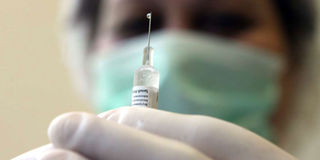New diphtheria vaccine to be developed in friendlier way

Scientists are working on a new diphtheria vaccine developed from cells grown in the lab. PHOTO | NATION MEDIA GROUP
Scientists are working on a new diphtheria vaccine developed from cells grown in the lab.
Diphtheria is a severe and highly infectious bacterial disease that causes inflammation of the mucous membranes and the formation of a false membrane in the throat which obstructs breathing and swallowing.
It is spread through airborne droplets contained in coughs or sneezes, saliva shared in drinks or kissing, as well as contaminated household items. It can kill or paralyse a patient by causing heart, nerve and muscle damage through the spread of a bacterial poison or toxin in the blood.
Researchers at MassBiologics, a non-profit manufacturer of vaccines in the Massachusetts Medical School, have now discovered a way to develop vaccines that protect against diphtheria. “The antibodies described here are promising candidates to replace horse antiserum,” the scientists wrote in a paper published in January in Scientific Reports journal.
The vaccine component or toxoid currently in use is developed by injecting horses with the disease and then extracting antibodies released to fight the disease from the animals’ immune system. The antibodies are harvested from the animals’ blood.
FATAL REACTION
The new method involves growing cells in a lab, sparing horses from the usually painful and uncomfortable process of getting injected with diphtheria so as to produce the antibodies.
Vaccination consists of a series of five injection shots usually given to children in the arm or thigh at the ages of two, four, six, 15 and 18 months as well as four to six years.
According to the Centres for Disease Control and Prevention, the current vaccine was developed around 1921, but was not widely used until the early 1930s.
In the 1940s, it was combined with the tetanus toxoid and whooping cough or pertussis vaccine and became the diphtheria, pertussis and tetanus (DPT) vaccine.
The latest version of this vaccine is known as the DTaP for children and Tdap for adolescents and adults.
The new vaccine is effective at prevention although some children may experience a few side effects including slight fever, drowsiness or tenderness at the injection site after a DTaP shot.
Statistics have shown that patients sometimes experience a negative, sometimes fatal reaction to the horse serum in up to five per cent of cases, a condition known as serum sickness.
Funds for the new vaccine type were provided by the animal rights protection group People for the Ethical Treatment of Animals and other organisations following concerns over the inhumane treatment of horses.


